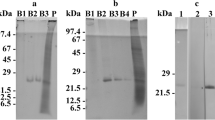Abstract
Polypeptides present in a membrane fraction of the marine macroalga Ulva sp. were separated by sodium dodecyl sulfate-polyacrylamide gel electrophoresis and tested for cross-reactivity with antibodies raised against the human red-blood-cell anion exchanger (AE1). A polypeptide of ca. 95 kDa was identified with a monoclonal, as well as two polyclonal (one against the C-terminus and one against the whole protein) antibodies, indicating that it shares homologous domains with AE1. These findings complement an earlier study which indicated that a plasmalemma-bound, disulfonic stilbenesensitive, protein was functionally involved in HCO -3 transport into the photosynthesizing cells of Ulva (Z. Drechsler et al. 1993, Planta 191, 34–40). It is thus suggested here that a similar protein has evolved, and has been conserved, in marine photosynthetic organisms and mammalian red blood cells for the purpose of HCO -3 transport.
Similar content being viewed by others
Abbreviations
- AE1:
-
anion exchanger 1 (of red blood cells)
- CI:
-
inorganic carbon
References
Beer, S., Israel, A., Drechsler, Z., Cohen, Y. (1990) Photosynthesis in Ulva fasciata. V. Evidence for an inorganic carbon concentrating system, and Rubisco CO2 kinetics. Plant Physiol. 94, 1542–1546
Björk, M., Haglund, K., Ramazanov, Z., Garcia-Reina, G., Pedersén, M. (1992) Inorganic-carbon assimilation in the green seaweed Ulva rigida C. Ag. (Chlorophyta). Planta 187, 152–156
Björk, M., Haglund, K., Ramazanov, Z., Pedersén, M. (1993) Inducible mechanisms for HCO -3 utilization and the repression of photorespiration in protoplasts of three species of Ulva (Chlorophyta). J. Phycol. 29, 166–173
Cabantchik, Z.I. (1990) The anion transport system of red blood cell membranes. In: Blood cell chemistry, pp. 337–364, Harris, M. ed., Plenum Press, New York
Cabantchik, Z.I., Greger, R. (1992) Chemical probes for anion transporters of animal cell membranes. Am. J. Physiol. 265, C803-C827
Cook, C.M., Lanaras, T., Colman, B. (1986) Evidence for bicarbonate transport in species of red and brown macrophytic marine algae. J. Exp. Bot. 37, 977–984
Drechsler, Z., Beer, S. (1991) The utilization of inorganic carbon by Ulva lactuca. Plant Physiol. 97, 1439–1444
Drechsler, Z., Sharkia, R., Cabantchik, Z.I., Beer, S. (1993) Bicarbonate uptake in the marine macroalga Ulva sp. is inhibited by classical probes of anion exchange by red blood cells. Planta 191, 34–40
Drechsler, Z., Sharkia, R., Cabantchik, Z.I., Beer, S. (1994) The relationship of arginine groups to photosynthetic HCO -3 uptake in Ulva sp. mediated by a putative anion exchanger. Planta 194, 250–255
Gutknecht, J., Bisson, M.A., Tostesson, F.C. (1977) Diffusion of carbon dioxide through lipid bilayer membranes: Effects of carbonic anhydrase, bicarbonate, and unstirred layers. J. Gen. Physiol. 69, 779–794
Jennings, M.L. (1985) Kinetics and mechanism of anion transport in red blood cells. Annu. Rev. Physiol. 47, 519–533
Jennings, M.L. (1992) Anion transport proteins. In: The kidney: physiology and pathophysiology, 2nd edn., Seldin, D.W., Giebish, G. eds. Raven Press, New York
Johnson, K.F. (1982) Carbon dioxide hydration and dehydration kinetics in seawater. Limn. Oceanogr. 27, 849–855
Larsson, C., Widell, S., Kjellbom, P. (1987) Preparation of high-purity plasma membranes. Methods Enzymol. 148, 558–568
Laemmli, U.K. (1970) Cleavage of structural proteins during the assembly of the head of bacteriophage T4. Nature 227, 680–685
Marder, J.B., Mattoo, A.K., Edelman, M. (1986) Identification and characterization of the psbA gene product: The 32-kDa chloroplast membrane protein. Methods Enzymol. 118, 384–396
Passow, H. (1986) Molecular aspects of band 3 protein-mediated anion transport across red blood cell membranes. Rev. Physiol. Biochem. Pharmacol. 103, 62–217
Schwarz-Ben Meir, N., Glaser, T., Kosower, N.S. (1991) Band 3 protein degradation by calpain is enhanced in erythrocytes of old people. Biochem. J. 275, 47–52
Smith, R.G., Bidwell, R.G.S. (1989) Mechanisms of photosynthetic carbon dioxide uptake by the red macroalga, Chondrus crispus. Plant Physiol. 89, 93–99
Szewczyk, B., Kozloff, L.M. (1985) A method for the efficient blotting of strongly basic proteins from sodium dodecyl sulphate — polyacrylamide gels to nitrocellulose. Anal. Bioch. 150, 403–407
Author information
Authors and Affiliations
Additional information
This paper is in partial fulfillment of a Ph.D. study by R. Sharkia. Supported by the Israel Academy of Sciences, grant 441/93 (to S.B.)
Rights and permissions
About this article
Cite this article
Sharkia, R., Beer, S. & Cabantchik, Z.I. A membrane-located polypeptide of Ulva sp. which may be involved in HCO -3 uptake is recognized by antibodies raised against the human red-blood-cell anion-exchange protein. Planta 194, 247–249 (1994). https://doi.org/10.1007/BF00196394
Received:
Accepted:
Issue Date:
DOI: https://doi.org/10.1007/BF00196394




